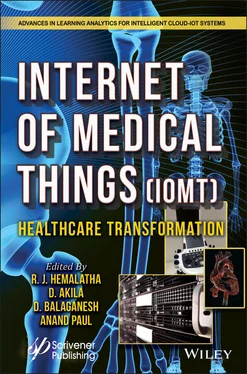The Internet of Medical Things (IoMT)
Здесь есть возможность читать онлайн «The Internet of Medical Things (IoMT)» — ознакомительный отрывок электронной книги совершенно бесплатно, а после прочтения отрывка купить полную версию. В некоторых случаях можно слушать аудио, скачать через торрент в формате fb2 и присутствует краткое содержание. Жанр: unrecognised, на английском языке. Описание произведения, (предисловие) а так же отзывы посетителей доступны на портале библиотеки ЛибКат.
- Название:The Internet of Medical Things (IoMT)
- Автор:
- Жанр:
- Год:неизвестен
- ISBN:нет данных
- Рейтинг книги:3 / 5. Голосов: 1
-
Избранное:Добавить в избранное
- Отзывы:
-
Ваша оценка:
- 60
- 1
- 2
- 3
- 4
- 5
The Internet of Medical Things (IoMT): краткое содержание, описание и аннотация
Предлагаем к чтению аннотацию, описание, краткое содержание или предисловие (зависит от того, что написал сам автор книги «The Internet of Medical Things (IoMT)»). Если вы не нашли необходимую информацию о книге — напишите в комментариях, мы постараемся отыскать её.
Providing an essential addition to the reference material available in the field of IoMT, this timely publication covers a range of applied research on healthcare, biomedical data mining, and the security and privacy of health records.
The Internet of Medical Things (IoMT) — читать онлайн ознакомительный отрывок
Ниже представлен текст книги, разбитый по страницам. Система сохранения места последней прочитанной страницы, позволяет с удобством читать онлайн бесплатно книгу «The Internet of Medical Things (IoMT)», без необходимости каждый раз заново искать на чём Вы остановились. Поставьте закладку, и сможете в любой момент перейти на страницу, на которой закончили чтение.
Интервал:
Закладка:
Keywords:Medical data, soft computing, fuzzy, cloud computing, data privacy, SVM, FCM
2.1 Introduction
There are many definitions in Electronic Health Record (EHR), such as the electronic record that holds patient information on a health record system operated by healthcare providers [1]. Although EHR has a good effect on healthcare services, development in many healthcare institutions globally, particularly in poor nations, is delayed due to numerous common problems. Patient data security has been a problem since the beginning of medical history and is an important issue in modern day. Initiated by the idea of confidentiality, the Oath of Hippocrates has proved to be an honorable activity in clinical and medical ethics. It is of highest importance to protect the privacy and confidentiality of patient information; security is trustworthy. Medical record security generally involves privacy and confidentiality [2]. Cloud computing provides the option of accessing massive amounts of patient information in a short period of time. This makes it easier for an unauthorized person to obtain patient records. It confirms this feeling by saying “illegal access to traditional medical records (paper-based) has always been conceivable, but computer introduction increases a little problem to a large problem.”
Cloud computing is a concept for easy, on-demand access to a common pool of configurable computer resources (e.g., networks, servers, storage, applications, and services), which may easily be provided and disclosed with minimal administration effort or engagement from service providers [4]. The newest, most exciting, and comprehensive solution in the world of IT is cloud computing. Its major purpose is to use the Internet or intranet to exchange resources for users [5]. Cloud computing is an affordable, automatically scalable, multi-tenant, and secure cloud service provider platform (CSP).
2.1.1 Security in Medical Big Data Analytics
Big data is complex and uncomplicated by its very nature and requires suppliers to take a close look at their techniques to collection, storage, analysis, and presentation of their data to personnel, business partners, and patients.
What are some of the most challenging tasks for enterprises when starting up a big data analytics program, and how can they overcome these problems to reach their clinical and financial goals?
2.1.1.1 Capture
All data comes from someone, but regrettably, it is not always from someone with flawless data management habits for many healthcare providers. Collecting clean, comprehensive, precise, and correctly structured data for numerous systems is a constant battle for businesses, many of whom are not on the gaining side of the conflict.
In a recent investigation at an ophthalmology clinic, EHR data were only 23.5% matched by patient-reporting data. When patients reported three or more eye problems, their EHR data were absolutely not in agreement.
Poor usability of EHRs, sophisticated processes, and an incomplete understanding why big data is crucial to properly collect all can contribute to quality problems that afflict data during its life cycle.
Providers can begin to improve the data capture routines by prioritizing valuable data types for their specific projects, by enlisting the data management and integrity expertise of professional health information managers, and by developing clinical documentation improvement programs to train clinicians on how to ensure data are useful for downstream analysis.
2.1.1.2 Cleaning
Health providers are familiar with the necessity of cleanliness in both the clinic and the operating room, but are not aware of the importance of cleaning their data.
Dirty data can swiftly ruin a large data analytics project, especially if multiple data sources are used to capture clinical or operational elements in slightly different formats. Data cleaning—also known as cleaning or scrubbing—guarantees accuracy, correctness, consistency, relevance, and in no way corruption of datasets.
While most data cleaning activities are still done manually, certain IT vendors provide automated scrubbing instruments that compare, contrast, and rectify big data sets using logic rules. These technologies may grow more sophisticated and accurate as machine learning techniques continue to progress rapidly, lowering time and cost necessary to guarantee high levels of accuracy and integrity in health data stores.
2.1.1.3 Storage
Clinicians at the front line rarely worry about the location of their data, yet it is a critical cost, safety, and performance issue for the IT department. Due to the exponential growth in the amount of health data, several suppliers can no longer manage the costs and implications on local data centers.
While many firms are more convenient to store data in the premises, which promises control over security, access, and up-time, the on-site server network can be costly, hard to operate, and prone to data silo production in various departments.
Cloud storage is becoming more and more common as costs decrease and reliability increases. Nearly, 90% of healthcare firms use some cloudbased IT infrastructure, including warehousing and applications in a 2016 survey.
The cloud promises a smooth recovery from disasters, reduced upfront costs, and simpler expansion—even though enterprises have to be exceedingly careful to select partners who understand the significance of HIPAA and other compliance and safety issues for health.
Many firms have a hybrid approach to their data store initiatives, which can offer providers with diverse access and storage requirements the most flexible and workable solution. However, providers should be careful to ensure that separate systems can communicate and share data with other sectors of the company when appropriate while establishing a hybrid infrastructure.
2.1.1.4 Security
Data security for healthcare businesses is the number one issue, particularly following a fast fire succession of high-profile violations, hackings, and ransomware outbreaks. From phishing assaults, viruses, and laptops left accidently in a cab, health information is exposed to an almost endless range of dangers.
The HIPAA Security Rule offers a broad set of technological guarantees for PHI storage organizations, including transmission security, authentication procedures and access, and integrity and auditing measures.
These precautions really lead to common sense safety processes, such as the use of up-to-date anti-virus software, the setup of firewalls, the encryption of sensitive data, and multi-factor authentication.
However, even the most closely secured data center can be overcome by personnel who tend to give priority over long software updates and sophisticated limits on their access to data or software.
Health organizations should often remind their staff members of the important nature of data security standards and continuously examine who has access to high-value data in order to prevent damage caused by malevolent parties.
2.1.1.5 Stewardship
Health data has a long shelf-life, especially on the clinical side. In addition to keeping patient data accessible for at least 6 years, clinicians may choose to use de-identified datasets for research projects, which is vital for continued stewardship and cure. For additional objectives, such as quality measurement or performance benchmarking, data may also be repurposed or re-assessed.
Understanding when and for what purposes the data were created—as well as who utilized it previously, why, how, and when—is vital to academics and data analysts.
Читать дальшеИнтервал:
Закладка:
Похожие книги на «The Internet of Medical Things (IoMT)»
Представляем Вашему вниманию похожие книги на «The Internet of Medical Things (IoMT)» списком для выбора. Мы отобрали схожую по названию и смыслу литературу в надежде предоставить читателям больше вариантов отыскать новые, интересные, ещё непрочитанные произведения.
Обсуждение, отзывы о книге «The Internet of Medical Things (IoMT)» и просто собственные мнения читателей. Оставьте ваши комментарии, напишите, что Вы думаете о произведении, его смысле или главных героях. Укажите что конкретно понравилось, а что нет, и почему Вы так считаете.












